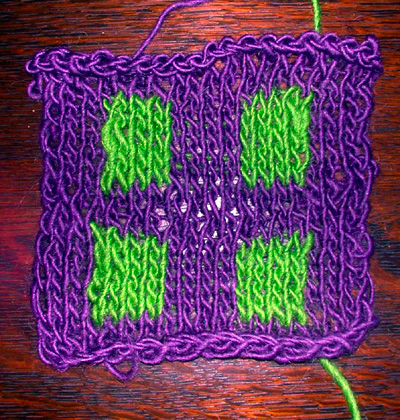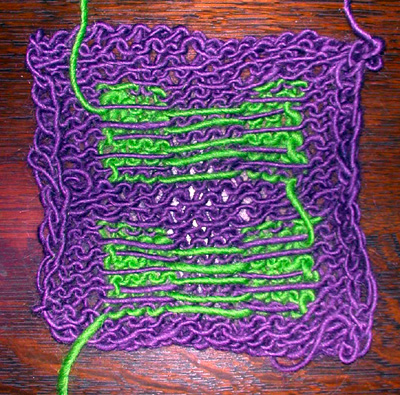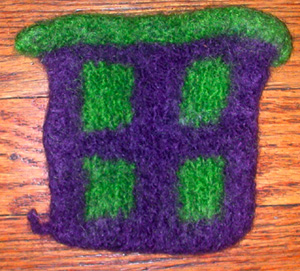|
The color pattern for this project is worked
using a slip stitch technique. This is an
easy way to create multi-color patterns because
you are only knitting with one strand of yarn
at a time. It also adds extra strength and
body to the fabric, which is advantageous
for a bag.
To keep the fabric of the finished bag consistent
between the solid rows and mulit-color rows,
slipped stitches are worked throughout the body.
The rows with the contrasting squares have groups
of four slipped stitches. The solid rows have
only single slipped stitches. To keep the tension
consistent, the solid-color rows are done using
a smaller needle size. The changing of needle
sizes throughout the bag ensures a more even
gauge throughout the body of the bag, especially
if you are a tight knitter.
THE TEST SWATCH
  Many
years ago, my father bought a toaster oven.
He brought it home and plugged it in. He was
about to put in a slice of bread to toast when
he found a slip of paper in the oven which read,
"Honestly now, have you read the instructions?" Many
years ago, my father bought a toaster oven.
He brought it home and plugged it in. He was
about to put in a slice of bread to toast when
he found a slip of paper in the oven which read,
"Honestly now, have you read the instructions?"
So, honestly now, are you going to do a test
swatch? Only the cavalier, or people who have
worked with this yarn for felting before, would
consider skipping this stage. The test swatch
seems more complicated than the actual handbag
because it is knitted flat, rather in the round.
It will only provide a moderately accurate gauge
swatch for that reason, but will give you a
bit of practice slipping four stitches and maintaining
even tension. It also gives a clear picture
of how your two colors of yarn will felt together
BEFORE you make the whole bag.
Throughout this pattern, all slipped
stitches are slipped purlwise, with yarn held
to the WS of the work.
Using MC and smaller needle, CO 20 stitches.
Row 1 [RS]: [K1, sl 1] to last 2 sts,
k2.
Row 2 [WS]: Sl 1, p to end.
Row 3 [RS]: [Sl 1, k1] to end.
Row 4 [WS]: Sl 1, p to end.
The next section is worked using the larger
needle. The work is not always turned at the
end of each row; when two RS or WS rows are
worked in a row, just slide your work to the
other end of the needle. The directions will
instruct you to "turn work" or "slide
work" accordingly.
Row 5 [RS]: Using larger needle and
CC, [sl 4, k4] twice, sl 4. Slide work.
Row 6 [RS]: Using MC, sl 1, k3, [sl
4, k4] twice. Turn work.
Row 7 [WS]: Using CC, [sl 4, p4] twice,
sl 4 wyif. Slide work.
Row 8 [WS]: Using MC, Sl 1, p3, [sl
4, p4] twice. Turn work.
Rows 9-12: Repeat Rows 5-8
.
Rows 13-14: Repeat Rows 5-6.
  The
next section is worked using the smaller needle
and MC only. Do not break CC; just carry it
loosely along the back of the work. The
next section is worked using the smaller needle
and MC only. Do not break CC; just carry it
loosely along the back of the work.
Row 15 [WS]: Using smaller needle and
MC, sl 1, p to end.
Row 16 [RS]: [Sl 1, p1] to end.
Row 17 [WS]: Sl 1, p to end.
Row 18 [RS]: Sl 2, k1, [sl 1, k1] to
last st, k1.
Row 19 [WS]: Sl 1, p to end. Slide
work.
The next section is worked using the larger
needle and both colors.
Row 20 [WS]: Using larger needle and
CC, [sl 4, p4] twice, sl 4 wyif. Turn work.
Row 21 [RS]: Using MC, sl 1, k3, [sl
4, k4] twice. Slide work.
Row 22 [RS]: Using larger needle and
CC, [Sl 4, k4] twice, sl 4. Turn work.
Row 23 [WS]: Using MC, Sl 1, p3, [sl
4, p4] twice. Slide work.
Rows 24-28: Repeat Rows 20-23.
Rows 29-30: Repeat Rows 20-21.
Break CC.
Rows 30-34: Using smaller needle and
MC, repeat Rows 15-19. Break MC.
  I-Cord
Bind Off: I-Cord
Bind Off:
This BO is worked using the larger needle and
CC. One MC stitch from the smaller needle is
worked together with the last stitch of each
row of I-Cord. Be sure to work this BO loosely.
I-Cord BO is worked with the RS facing at all
times.
Using larger needle and CC, CO 3 sts.
Row 1: K2, sl 1, k1 from smaller needle,
psso. Slide work to other end of needle and
bring yarn around back of work, ready to work
the next row.
Repeat this row until all sts have been
bound off. Break CC, draw through sts on needle
and pull tight; use tapestry needle to draw
yarn tail down through body of I-Cord.
Felt this swatch in the washing machine next
time you run a hot load - be sure not to use
bleach. Place it in a zippered pillowcase to
keep the lint contained, and to reducing staining
of your other clothing. Keep track of how long
it was in the machine, so you have some idea
of how your final felting process will go.
|

